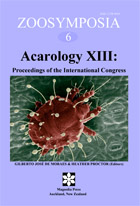Abstract
The results generated by theMulti Locational Project onAgriculturalAcarology,All India Coordinated Project onAgriculturalAcarology, Network Project onAgriculturalAcarology and the Network Project on Insect Biosystematics since 1983 are described, highlighting the most important mite pests of north India. The following species are considered major pests in that region: Tetranychidae - Eutetranychus orientalis (Klein), Oligonychus coffeae (Nietner), Tetranychus ludeni Zacher, Tetranychus neocaledonicus André and Tetranychus urticae Koch; Eriophyidae - Aceria litchii (Keifer) and Aceria mangiferae (Sayed); Tarsonemidae - Polyphagotarsonemus latus (Banks). Other 16 species in those families as well as in the Tenuipalpidae are also considered important as plant pests in this area of India.Among the tetranychids, T. ludeni was identified as an alarming problem in 1987. Many outbreaks of this pest were recorded from 1988 to 1990 on cowpea [Vigna unguiculata (L.)Walp], an important summer vegetable of eastern Uttar Pradesh. Okra (Abelmoschus esculentus Moench) and eggplant (Solanum melongena L.), particularly when grown in the summer, have serious problems with T. urticae and Tetranychus macfarlanei Baker & Pritchard. Panonychus ulmi (Koch) has emerged as a serious problem on the expanding cultivation of apple in Himachal Pradesh, whereas Petrobia latens (Muller) populations are increasing in dryland cultivation of Rajasthan, attaining serious pest status mainly on wheat and coriander. Among the tarsonemids, a serious increase in P. latus on chilli has coincided with the growing cultivation of this crop, whereas increasing population levels of Steneotarsonemus spinki Smiley have caused severe damage to rice since its recent discovery in northern India. Serious problems have also been caused to tomato by the eriophyid Aceria lycopersici (Wolf) and to ber (Ziziphus mauritiana Lam.) by the tenuipalpid Larvacarus transitans (Ewing), an emerging serious pest of in Rajasthan area. The reason attributed to the increasing mite infestations is the widespread and continuous use of synthetic pyrethroid pesticides, which negatively affect the predatory mite fauna. The paper focuses on problems of mite outbreak and suggests future thrust for use of predatory mites as bio-agents for integrated mite control.

